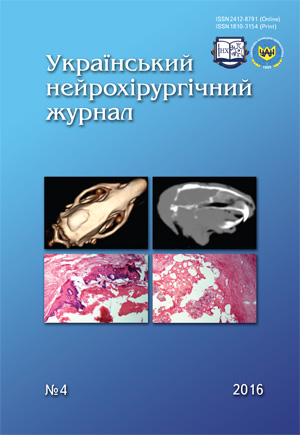Сervical microdiscectomy: method and surgical strategy
DOI:
https://doi.org/10.25305/unj.86579Keywords:
herniated disc, surgical treatment, cervical microdiscectomy, interlaminar approachAbstract
Objective. To implement the interlaminar lateral approach for extraction of herniated discs (HD) in the cervical spine.
Materials and methods. During 2012–2015 in Regional psychoneurological hospital 56 patients with cervical HD were operated. There were 22 females, 36 males among them. Disc herniation at the CV–CVI level occurred in 21 cases, CVI–CVII in 20 cases. The main disease signs were cervicalgia, monoradiculopathy. Fifty patients with medial hernia were operated using anterior cervical microscopic discectomy approach to HP extraction and intervertebral cage implantation (PEEK material). Six patients with lateral hernia were operated using posterior interlaminar cervical microdiscectomy. Anterior approach was performed by a standard method using CODMAN retractor, high-speed drill Stryker TPS. The posterior interlaminar approach was performed using paramedian incision 3 cm, intermuscular approach to the posterior lateral mass and arch on the affected side with Medtronic Metrix system followed by interlaminectomy performed by high-speed drill not more than 1 cm that was rather enough for hernia extraction from under nerve root.
Results. In all cases we managed to achieve the regression of radicular and cervicalgia syndromes. No complications were fixed during both surgical approaches. There was no difference observed in duration of surgical intervention using both methods, which was about (64±12) min. All patients were verticalized and activated in 3–4 hours after surgery.
Conclusion. Cervical microdiscectomy is a standard method for cervical HD surgery. The posterior interlaminar approach is an effective method used for lateral herniations, especially sequestered ones. It promotes the preservation of intervertebral disc and reduction of the total cost of surgery due to no necessity to use the implants-prosthesis. We suppose the posterior cervical microdiscectomy of lateral, sequestered intervertebral disc herniations in cervical spine to become a standard method of treatment.
References
Greenberg MS. Handbook of Neurosurgery. Tampa, Fla.: Greenberg Graphics; 2010.
Dohrmann GJ, Hsieh JC. Long-term results of anterior versus posterior operations for herniated cervical discs: analysis of 6,000 patients. Med Princ Pract. 2014;23(1):70-3. [CrossRef] [PubMed]
Iyer S, Kim HJ. Cervical radiculopathy. Curr Rev Musculoskelet Med. 2016;9(3):272-80. [CrossRef] [PubMed]
Finn MA, MacDonald JD. C2-3 anterior cervical fusion: technical report. Clin Spine Surg. 2016 May 11. [Epub ahead of print]. [PubMed]
Gore DR, Sepic SB. Anterior discectomy and fusion for painful cervical disc disease. A report of 50 patients with an average follow-up of 21 years. Spine (Phila Pa 1976). 1998;23(19):2047-51. [PubMed]
Kerry G, Hammer A, Ruedinger C, Ranaie G, Steiner HH. Microsurgical posterior cervical foraminotomy: a study of 181 cases. Br J Neurosurg. 2016 Jul 11:1-6. [Epub ahead of print]. [PubMed]
Russell SM, Benjamin V. Posterior surgical approach to the cervical neural foramen for intervertebral disc disease. Neurosurgery. 2004;54(3):662-6. [PubMed]
Daglı M, Er U, Simşek S, Bavbek M. Late results of anterior cervical discectomy and fusion with interbody cages. Asian Spine J. 2013;7(1):34-8. [CrossRef] [PubMed]
Korinth M, Krьger A, Oertel M, Gilsbach J. Posterior foraminotomy or anterior discectomy with polymethyl methacrylate interbody stabilization for cervical soft disc disease: results in 292 patients with monoradiculopathy. Spine. 2006;31(11):1207-14. [CrossRef] [PubMed]
Skovrlj B, Gologorsky Y, Haque R, Fessler RG, Qureshi SA. Complications, outcomes, and need for fusion after minimally invasive posterior cervical foraminotomy and microdiscectomy. Spine J. 2014;14(10):2405-11. [CrossRef] [PubMed]
Caglar YS, Bozkurt M, Kahilogullari G, Tuna H, Bakir A, Torun F, Ugur HC. Keyhole approach for posterior cervical discectomy: experience on 84 patients. Minim Invasive Neurosurg. 2007;50(1):7-11. [PubMed]
Downloads
Published
How to Cite
Issue
Section
License
Copyright (c) 2016 Valeriy Olkhov, Kostyantyn Horbatyuk, Oleksiy Stoliarenko

This work is licensed under a Creative Commons Attribution 4.0 International License.
Ukrainian Neurosurgical Journal abides by the CREATIVE COMMONS copyright rights and permissions for open access journals.
Authors, who are published in this Journal, agree to the following conditions:
1. The authors reserve the right to authorship of the work and pass the first publication right of this work to the Journal under the terms of Creative Commons Attribution License, which allows others to freely distribute the published research with the obligatory reference to the authors of the original work and the first publication of the work in this Journal.
2. The authors have the right to conclude separate supplement agreements that relate to non-exclusive work distribution in the form of which it has been published by the Journal (for example, to upload the work to the online storage of the Journal or publish it as part of a monograph), provided that the reference to the first publication of the work in this Journal is included.









